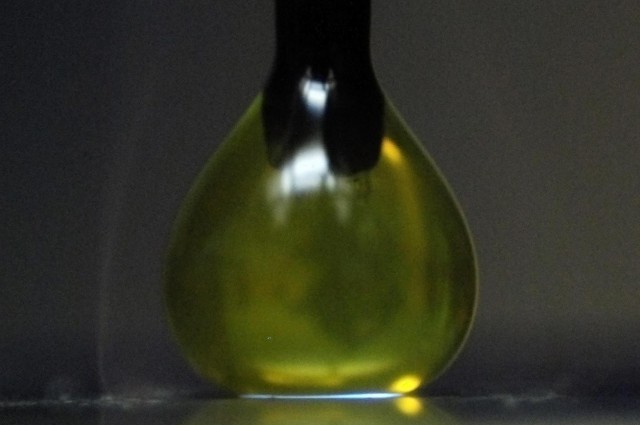A team of French scientists, curious as to just how good a conductor of electricity hydrochloric acid really is, made a surprising discovery when they gave the liquid a jolt of electricity: a pale blue streak of light separated the droplet from the table upon which it was applied.
That blue streak — it came from plasma, similar to the substance that lightning is made from. Blue glow from beneath a levitating droplet of hydrochloric acid. Via Cedric Poulain et al./CEA
Blue glow from beneath a levitating droplet of hydrochloric acid. Via Cedric Poulain et al./CEA
Now, anyone remotely familiar with chemistry will point out that this result is pretty similar to the Leidenfrost effect, wherein a droplet of water gets dropped onto a super-hot surface and instead of boiling and fizzing away as gas, the water drops levitate slightly above the surface and bead up to form drops of water. The reason this happens is because the surface, which is hotter than the boiling point of water, vaporizes a layer of gas between the liquid droplet and the surface, thereby trapping the water molecules together as a combined droplet.
In terms of the acid-electricity experiment, the electricity turned some of the liquid into a vapor that then ionized into plasma.
Diving into some of the more granular details of this experiment, the acid drop was suspended atop a metal plate with a voltage applied across it. When the drop fell towards the plate, it started to undergo a transformation from hydrochloric liquid to hydrogen and oxygen gas. When the team increased the voltage to 50 volts, they noted the droplet sparked and emitted its own light. Furthermore, it levitated slightly, floating above the surface of the electrified plate, and in between the droplet and surface was the blue glow coming from the plasma.
Being scientists, the group was naturally skeptical of their findings—at first, they thought it was hydrogen gas. Further tests took place, and this idea was disproved—the cushion the droplet was “levitating” upon was mostly made of vaporized water.
Looking ahead, this discovery could lead to the creation of dense plasma with little voltage. Obviously, more works needs to be done before this discovery sees real world application. One of the things that needs greater understanding — the plasma that’s being created via this method is composed of two different types of plasma, a result not fully understood by the scientific community (yet). The team’s next goal is to further study these layers and to also figure out what exactly is happening the moment the droplet taps the electrified surface and creates a spark.
You can read the team’s full results in Applied Physics Letters.
Via IFLscience
Advertisement
Learn more about Electronic Products Magazine





